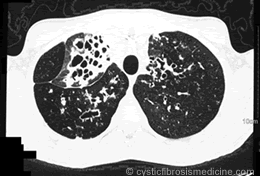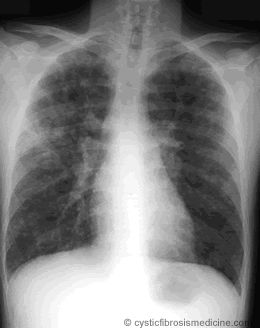Non-tuberculous mycobacteria and Cystic fibrosis
Introduction
With the widespread use of antibiotics and dramatic improvement in patients survival, newer organisms, such as Stenotrophomonas maltophilia (Denton et al, 1996; Denton et al, 1998; Talmaciu et al, 2000; Krzewinski et al, 2001), Achromobacter xylosoxidans (Dunne & Maisch, 1995; Krzewinski et al, 2001; Tan et al, 2002) and nontuberculous mycobacteria (Tomashefski et al, 1996; Torrens et al, 1998; Olivier et al, 2003) are becoming more widespread. The reasons for their emergence are complex but may relate to the selective pressure exerted by repeated exposure to antibiotic therapy, improved laboratory isolation techniques and enhanced reporting. All may be associated with either simple colonisation or respiratory exacerbations in those persistently colonised with large numbers of these organisms.
Nontuberculous mycobacteria
The prevalence of nontuberculous mycobacteria (NTMs) in the Adult CF Unit in Leeds was 3.8% in 1998 (Torrens et al, 1998). More recent studies suggest that this might now be higher. Pierre-Audigier et al reported a prevalence of 8.1% in three French CF Centres (Pierre-Audigier et al, 2005) and Olivier et al reported an overall prevalence of 13% from 21 CF Centres in the USA (Olivier et al, 2003). Prevelance is age-related with lower rates seen in children (Esther et al, 2005; Pierre-Audigier et al, 2005). The NTMs associated with CF can be broadly separated into three groupings: Mycobacterium avium complex; rapid growers consisting of Mycobacterium abscessus, Mycobacterium chelonae and Mycobacterium fortuitum; and others. The most commonly isolated species in CF are M. avium complex and the rapid growers, especially M. abscessus (Torrens et al, 1998; Olivier et al, 2003; Esther et al, 2005; Pierre-Audigier et al, 2005). The source of NTMs for persons with CF remains elusive and there is no evidence of patient-to-patient spread (Sermet-Gaudelus et al, 2003).
Clinical significance of NTM in cystic fibrosis
The clinical significance of NTMs varies from patient to patient. Assessment can be aided by the use of American Thoracic Society criteria (American Thoracic Society, 1997), which are based on clinical, microbiological and radiological parameters, although these have not been specifically validated for CF. M. abscessus is the species most closely associated with clinical significance (Pierre-Audigier et al, 2005) and infection may become chronic and lifelong. It has been suggested that infection with atypical mycobacteria should not be an exclusion criterion for lung transplantation. Although 14% of people with CF undergoing lung transplantation were positive for atypical mycobacteria in one study, the prevalence of post-transplant invasive mycobacterial infection was low (3.4%) and was associated entirely with M. abscessus (Charlermskulrat et al, 2006). The latter should be seen as a strong relative, if not absolute, contraindication to lung transplant. Disseminated pulmonary infection may occur post transplant despite aggressive therapy (Taylor & Palmer, 2006).

Figure 1. Mycobacterium. avium and granuloma – biopsy proven

Figure 2. Mycobacterium. chelonae and granuloma found on lung biopsy following a pneumothorax

Figure 3. Acute deterioration due to Mycobacterium abscessus which responded to intense therapy
It is not clear what the optimum treatment regimens for NTMs are and much of the evidence is provided by in-vitro rather than in-vivo studies. They are often resistant to most of the antibiotics commonly used to treat other infections in CF and to standard treatments used to treat Mycobacterium tuberculosis. Most isolates of M. avium appear susceptible to macrolides, such as clarithromycin and azithromycin, on initial isolation (Heifets, 1996) and these are most effective when combined with two or three other drugs, such as rifampicin and ethambutol (Yajko et al, 1996; Field et al, 2004). The most active drug against rapid growers is amikacin, although other agents with in vitro activity include cefoxitin, clarithromycin, imipenem and linezolid (Brown-Elliot & Wallace, 2002; Yang et al, 2003). M abscessus is more resistant than other members of the group. Tigecycline has in vitro activity against rapid growers, but not against M. avium (Wallace et al, 2002). There is some evidence that patients with defects in immunological pathways, particularly those associated with interferon, may be more susceptible to infection with NTMs. The use of aerosolised interferon has been anecdotally associated with successful treatment of M. abscessus infection in CF (Hallstrand et al, 2004). In Leeds we have developed a treatment algorithm based on the currently available data. Further studies are needed to ascertain the optimum management of NTMs in CF.
Key points
• The clinical significance of NTMs varies from patient to patient
• M. abscessus is the species most closely associated with clinical significance and infection may become chronic and lifelong
• It is not clear what the optimum treatment regimens for NTMs are and much of the evidence is provided by in-vitro rather than in-vivo studies
• In Leeds we have developed and follow a treatment algorithm based on the currently available data
References
American Thoracic Society (ATS). Diagnosis and treatment of disease caused by nontuberculous mycobacteria. Am J Respir Crit Care Med 1997; 156: S1-S25. [PubMed]
Brown-Elliot BA, Wallace RJ Jr. Clinical and taxonomic status of pathogenic non-pigmented or late-pigmenting of rapidly growing mycobacteria. Clin Microbiol Rev 2002; 15: 716-746. [PubMed]
Charlemskulrat W, Sood N, Neuringer IP, et al. Non-tuberculous mycobacteria in end-stage cystic fibrosis: implications for lung transplantation. Thorax 2006; 61: 507-513. [PubMed]
Denton M, Todd NJ, Littlewood JM. Role of anti-pseudomonal antibiotics in the emergence of Stenotrophomonas maltophilia in cystic fibrosis patients. Eur J Clin Microbiol Infect Dis 1996; 15: 402-405. [PubMed]
Denton M, Todd NJ, Kerr KG, et al. Molecular epidemiology of Stenotrophomonas maltophilia isolated from clinical specimens from patients with cystic fibrosis and associated environmental samples. J Clin Microbiol 1998; 36: 1953-1958. [PubMed]
Dunne WM Jr, Maisch S. Epidemiological investigation of infections due to Alcaligenes species in children and patients with cystic fibrosis: use of repetitive-element sequence polymerase chain reaction. Clin Infect Dis 1995; 20: 836-841. [PubMed]
Esther CR Jr, Henry MM, Molina PL, et al. Nontuberculous mycobacterial infection in young children with cystic fibrosis. Pediatr Pulmonol 2005; 40: 39-44. [PubMed]
Field SK, Fisher D, Cowie RL. Mycobacterium avium complex pulmonary disease in patients without HIV infection. Chest 2004; 126: 566-581. [PubMed]
Hallstrand TS, Ochs HD, Zhu Q, et al. Inhaled IFN- γ for persistent nontuberculous mycobacterial pulmonary disease due to functional IFN-γ deficiency. Eur Respir J 2004; 24: 367-370. [PubMed]
Heifets L. Susceptibility testing of Mycobacterium avium complex isolates. Antimicrob Agents Chemother 1996; 40: 1759-1767. [PubMed]
Krzewinski JW, Nguyen CD, Foster JM, et al. Use of random amplified polymorphic DNA PCR to examine epidemiology of Stenotrophomonas maltophilia and Achromobacter (Alcaligenes) xylosoxidans from patients with cystic fibrosis. J Clin Microbiol 2001; 39: 3597-3602. [PubMed]
Olivier KN, Weber DJ, Wallace Non-tuberculous mycobacteria and Cystic fibrosisRJ Jr, et al. Nontuberculous mycobacteria I: multicenter prevalence study in cystic fibrosis. Am J Respir Crit Care Med 2003; 15: 828-834. [PubMed]
Pierre-Audigier C, Ferroni A, Sermet-Gaudelus I, et al. Age-related prevalence and distribution of nontuberculous mycobacterial species among patients with cystic fibrosis. J Clin Microbiol 2005; 43: 3467-3470. [PubMed]
Sermet-Gaudelus I, Le Bourgeois M, Pierre-Audigier C, et al. Mycobacterium abscessus and children with cystic fibrosis. Emerg Infect Dis 2003; 9: 1587-1591. [PubMed]
Talmaciu I, Varlotta L, Mortensen J, et al. Risk factors for emergence of Stenotrophomonas maltophilia in cystic fibrosis. Pediatr Pulmonol 2000; 30: 10-15. [PubMed]
Tan K, Conway SP, Brownlee KG, et al. Alcaligenes infection in cystic fibrosis. Pediatr Pulmonol 2002; 34: 101-104. [PubMed]
Taylor JL, Palmer SM. Mycobacterium abscessus chest wall and pulmonary infection in a cystic fibrosis lung transplant recipient. J Heart Lung Transplant 2006; 25: 985-988. [PubMed]
Tomashefski JF Jr, Stern R, Demko CA, et al. Nontuberculous mycobacteria in cystic fibrosis. An autopsy study. Am J Respir Crit Care Med 1996; 154: 523-528. [PubMed]
Torrens JK, Dawkins P, Conway SP, et al. Non-tuberculous mycobacteria in cystic fibrosis. Thorax. 1998 ; 53: 182-185. [PubMed]
Wallace RJ Jr, Brown-Elliot BA, Crist CJ, et al. Comparison of the in vitro activity of the glycylcycline tigecycline (formerly GAR-936) with those of tetracycline, minocycline, and doxycycline against isolates of nontuberculous mycobacteria. Antimicrob Agents Chemother 2002; 46: 3164-3167. [PubMed]
Yajko D, Sanders CA, Madej JJ, et al. In-vitro activities ofrifabutin, azithromycin, ciprofloxacin, clarithromycin, clofazimine, ethambutol, and amikacin in combinations of two, three, and four drugs against Mycobacterium avium. Antimicrob Agents Chemother 1996; 40: 743-749. [PubMed]
Yang SC, Hsueh PR, Lai HC, et al. High prevalence of antimicrobial resistance in rapidly growing mycobacteria in Taiwan. Antimicrob Agents Chemother 2003; 47: 1958-1962. [PubMed]
